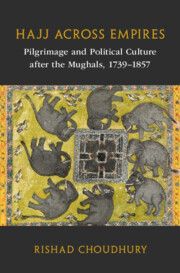Book contents
- Hajj across Empires
- Asian Connections
- Hajj across Empires
- Copyright page
- Dedication
- Epigraph
- Contents
- Figures
- Maps
- Tables
- Preface and Acknowledgments
- Note on Transliterations and Translations
- Abbreviations
- Maps
- Introduction
- Part I Departures
- Part II Crossings
- 3 The ʿUlama on Hajj
- 4 Hindi Sufis and the Hajj
- Part III Returns
- Bibliography
- Index
- Asian Connections
4 - Hindi Sufis and the Hajj
from Part II - Crossings
Published online by Cambridge University Press: 01 February 2024
- Hajj across Empires
- Asian Connections
- Hajj across Empires
- Copyright page
- Dedication
- Epigraph
- Contents
- Figures
- Maps
- Tables
- Preface and Acknowledgments
- Note on Transliterations and Translations
- Abbreviations
- Maps
- Introduction
- Part I Departures
- Part II Crossings
- 3 The ʿUlama on Hajj
- 4 Hindi Sufis and the Hajj
- Part III Returns
- Bibliography
- Index
- Asian Connections
Summary
Chapter 4 more resolutely follows Indian pilgrims beyond India. It thus surveys the remarkable ascendance, on the broader circuits of the hajj, of an institutional network meant for Indian Sufi pilgrims, a series of linked lodges that sprawled from Arabia, Syria, Anatolia, to Istanbul. Mainly through Ottoman sources, the chapter demonstrates how banded and corporatized attitudes formed among mobile and migrant South Asian pilgrims in the Middle East, and how these social formations in turn animated the authority and influence of “neo-Sufi” groups of Naqshbandis and Qadiris. Taking readers into the built environments of the so-called Hindi or “Indian” Sufi lodges of the Ottoman empire, the chapter additionally explores how the hajj gave way not only to forms of cultural cosmopolitanisms but also cultural differences among globally interacting Muslims. As the chapter argues, due to an influx of Indian pilgrims into the Hindi Sufi lodges, their institutional identities as sites and spaces of sociability for South Asian pilgrims abroad sharpened during the eighteenth century. Simultaneously, however, itinerant Indian Sufis also drew on Ottoman channels of social communications, legal petitioning strategies, and state and interstate linkages to successfully situate themselves as “transimperial subjects” straddling South Asia and the Middle East.
- Type
- Chapter
- Information
- Hajj across EmpiresPilgrimage and Political Culture after the Mughals, 1739–1857, pp. 151 - 190Publisher: Cambridge University PressPrint publication year: 2024

